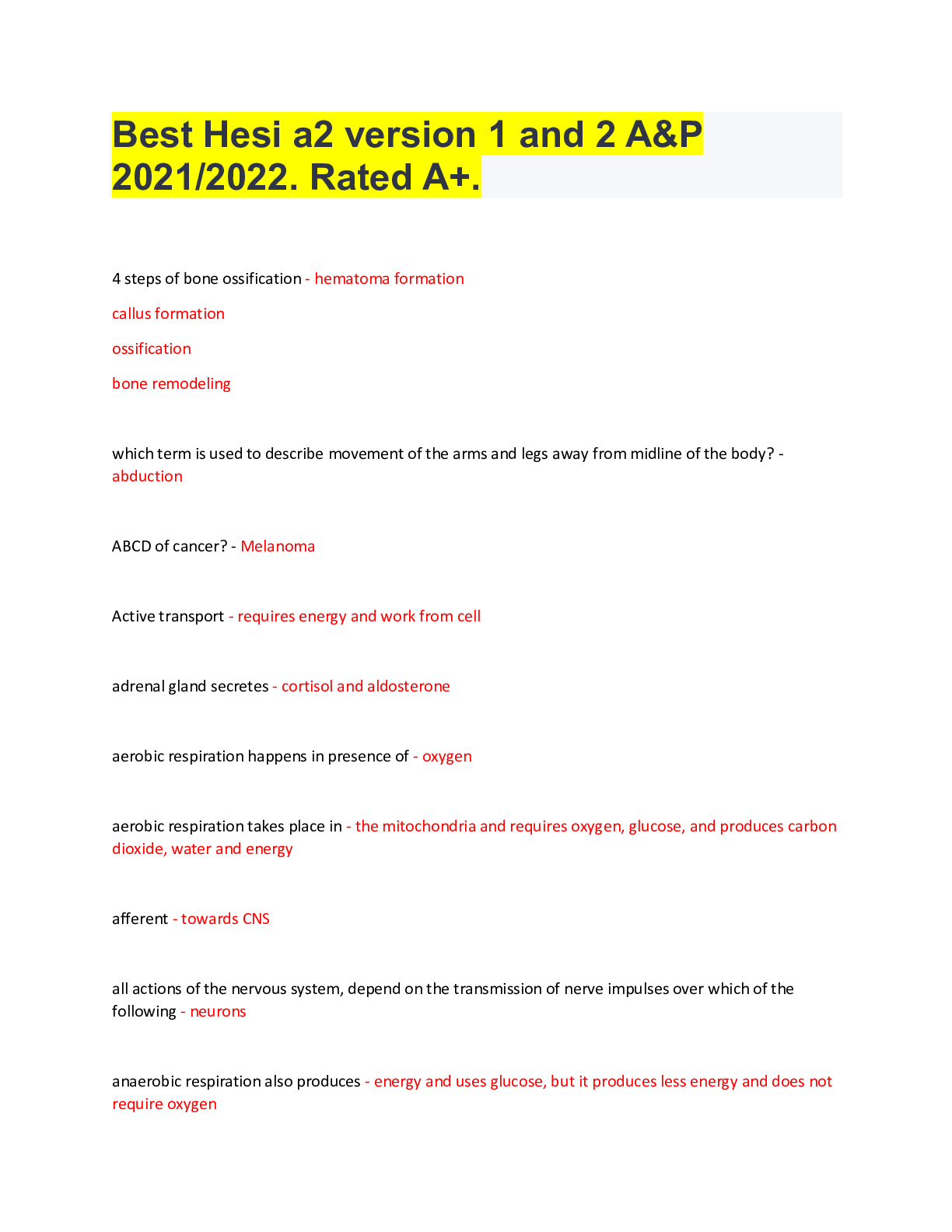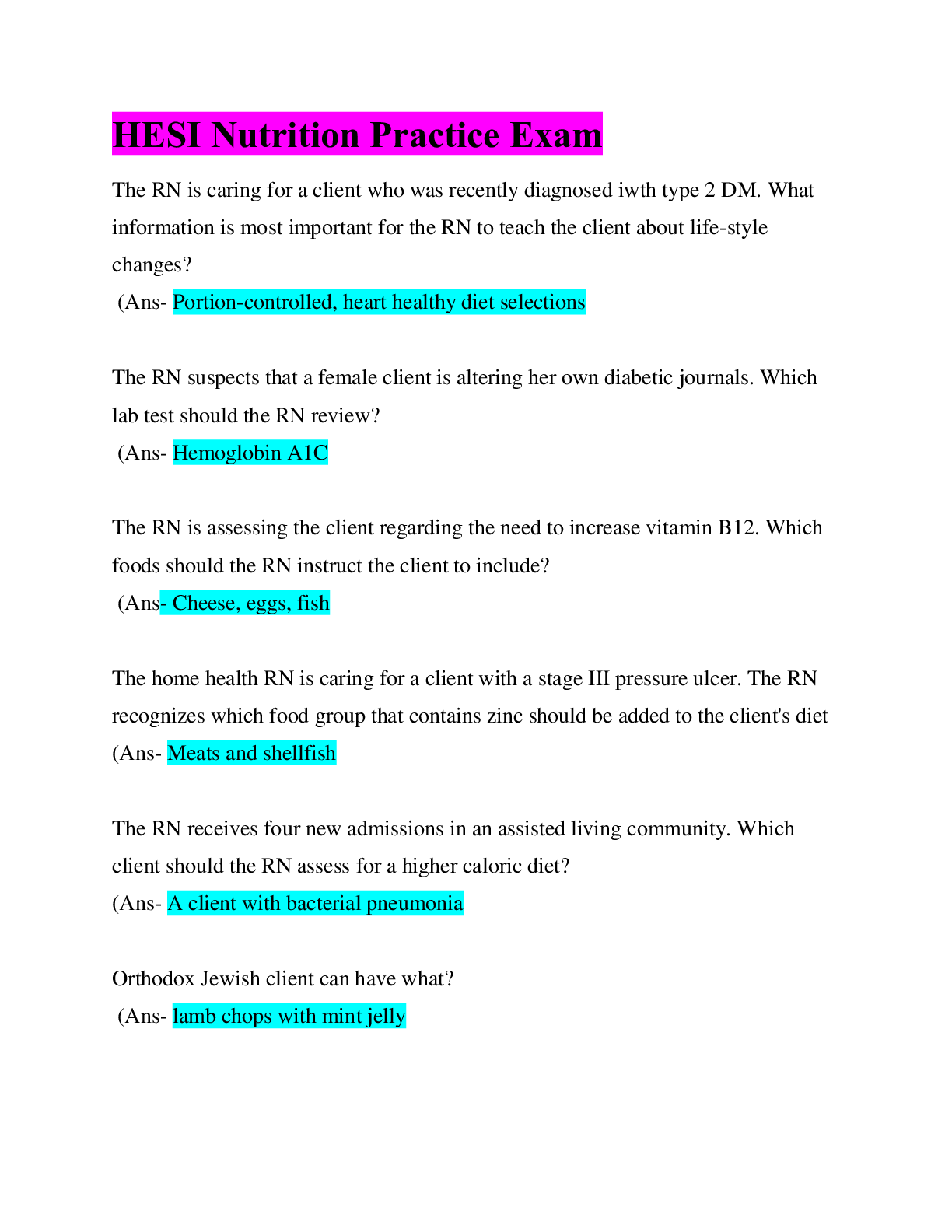Best Hesi a2 version 1 and 2 A&P 2021/2022. Rated A+.
Document Content and Description Below
4 steps of bone ossification - hematoma formation callus formation ossification bone remodeling which term is used to describe movement of the arms and legs away from midline of the body? - abdu... ction ABCD of cancer? - Melanoma Active transport - requires energy and work from cell adrenal gland secretes - cortisol and aldosterone aerobic respiration happens in presence of - oxygen aerobic respiration takes place in - the mitochondria and requires oxygen, glucose, and produces carbon dioxide, water and energy afferent - towards CNS all actions of the nervous system, depend on the transmission of nerve impulses over which of the following - neurons anaerobic respiration also produces - energy and uses glucose, but it produces less energy and does not require oxygen anaerobic respiration can lead to a burning sensation caused by which molecule - lactic acid aqueous humor is watery fluid in which part of the body - eye as part of the negative feedback system, which type of cell is stimulated to resorb bone matrix in response to a decrease in calcium in the blood - osteoclasts aspirin occurs when there is a tear in which structures - ligament auricle - a thin pouch in the heart autonomic nervous system - involuntary movements(sympathetic and parasympathetic nervous system) blood that has supplied nutrients and oxygen to heart muscle returns to right atrium via - coronary sinus the buttocks are which surface of the body - dorsal calcaneus is located in - foot calciferol is controlled by - parathyroid capillaries - carry blood away from boy in order to exchange nutrients, oxygen and waste carbiligonus - connection between articulating bones made up of cartilage cellular contact is important for - wound healing ceruminous glands secrete - ear wax client has large pituitary tumor what part of the body does this effect? - head hurt, sickness, low blood pressure diet is important because bones are storage places for - calcium and phosphorus diffusion - the passive movement of molecules or particles along concentration gradient, or form regions of higher to regions of lower concentration diploid - 46 chromosomes distal conciliated tunnel works with hormone - ADH distal consulted tubule is controlled by - PTH dorsiflexion, plantar flexion are types of joint movement that are associated with which part of the body? - foot efferent - away from CNS endocytosis - engulfs and brings in esophagus is part of the - digestive system eustachian tube - links the nasopharynx to the middle ear exocytosis - fuses within plasma membrane and releases content outside of cell fertilization occurs in the - oviduct (fallopian tube) fertilization of an ovum occurs in which anatomical structure - Fallopian tubes fibrous joint - immovable and held together by ligaments only (ex. teeth in socket) functional units of kidney - nephrons function of parathyroid - activation of vitamin D gallbladder is part of - digestive system Gamete - mature haploid male or female germ cell that is able to unite with another of the opposite sex in sexual reproduction to form zygote Golgi apparatus functions as - process protein secretion, synthesize carbs and glycoproteins haploid - 23 chromosomes why does HCL harm the stomach and not absorbed - protected by mucus lining heart with largest layer - left ventricle how many carb per gram do carbohydrates contain - 4 how many days is the average menstrual cycle - 28 days increase in rate of depth results In what blood PH change - alkalosis in order for inhalation to occur what must happen - contraction of the diaphragm which enlarges the chest cavity and draws air inspiration - expands thoracic cavity in white blood cells what contributes to phagocytosis - macrophages, neutrophils layers of epidermis (outer to inner) - corneum, lucidum, granulosum, spinosum, basale (Can Lili Grant Serena Boys) ligament - bone to bone ligaments provide connection to? - bone to bone lymphocytes - important in immune system the malleus incus and stapes are located in which part of the body - the mediastinum is located within which cavity - thoracic high levels of which ion would most likely result in cardiac arrest - Potassium which hormones are produced by the ovaries - estrogen and progesterone how does lymph work with circulatory - lymph draws excess fluid from the cells and deposits it into blood vessels how does nervous system work with muscular - tells muscles how to respond to environment how is pepsin used in the body - breakdown proteins meiosis - process of cell division that occurs in five stages before pinching two daughter cells in a process called cytokinesis the mitral valve is located between which two structures - left ventricle and left atrium monocytes - becomes macrophages most abundant tissue - connective tissue most obvious skin cancer - basal cell carcinoma neutrophils - A type of white blood cell that engulfs invading microbes and contributes to the nonspecific defenses of the body against disease. muscle contraction that moves food through digestive tract - peristalisis The occipital region is located in which part of the body? - head order of organization of living things - organelle, cells, tissues, organs, organ systems, organisms, populations, communities, ecosystem, and biosphere. the organ of corti is located in - ear osmosis - Diffusion of water through a selectively permeable membrane parts of sternum - manubrium, body, xiphoid process passive transport and examples - doesn't require energy (ex. diffusion and osmosis) a person who has damaged the ulnar nerve will have decreased sensation in which area - arm photosynthesis - uses sunlight to synthesize foods, from carbon dioxide and water pituitary glands produces - adrenocorticotropic hormone (GH) plane divides the body into right and left sides - sagittal polypeptides are - chains of amino acids the ribs are attached to - sternum the rough endoplasmic reticulum functions in human cell to - synthesize protein osteocytes - mature bone cells an overproduction of cerumen (earwax) can accumulate in which area - ovum - A mature egg cell oxytocin - A hormone released by the posterior pituitary that stimulates uterine contractions during childbirth and milk ejection during breastfeeding. part of the brain that attaches to the spinal cord - oblongata sebaceous glands - secretes oil separates abdominal and thoracic cavity - diaphragm skeletal system function - protection, movement, mineral storage, production [Show More]
Last updated: 2 years ago
Preview 1 out of 12 pages

Buy this document to get the full access instantly
Instant Download Access after purchase
Buy NowInstant download
We Accept:

Reviews( 0 )
$9.00
Can't find what you want? Try our AI powered Search
Document information
Connected school, study & course
About the document
Uploaded On
Mar 28, 2022
Number of pages
12
Written in
Seller

Reviews Received
Additional information
This document has been written for:
Uploaded
Mar 28, 2022
Downloads
0
Views
100











 (A Graded) Latest Questions and Complete Solutions.png)
 Health Information Systems Test Bank, Complete Preparation Practice Test Questions, Questions 50 (Latest Update) (A Graded).png)
 (A Graded) Latest Questions and Complete Solutions.png)
 (A Graded).png)
 (A Graded) Latest Questions and Complete Solutions.png)
 (A Graded) Latest Questions and Complete Solution.png)




